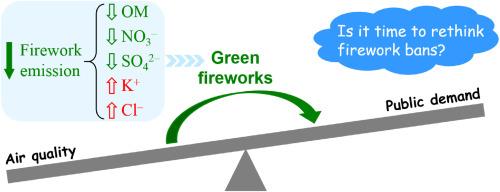Significant annual variations of firework-impacted aerosols in Northeast China: Implications for rethinking the firework bans
IF 4.2
2区 环境科学与生态学
Q2 ENVIRONMENTAL SCIENCES
引用次数: 0
Abstract
Fireworks are banned in many Chinese cities but never eliminated, reflecting strong public demand on this traditional activity for festival celebrations. On the other hand, the assessment of firework contributions to air pollution remains vague, raising concerns on the necessity of the mandatory bans. Here we investigated the characteristics of firework episodes in a megacity in Northeast China, based on field campaigns conducted in four successive winters during 2018–2022. Although prohibited, the firework influences remained evident during the Chinese New Year periods, as suggested by the enhancements of water-soluble potassium (K+). In addition, significant annual variations were identified for the firework episodes, with the following features observed. First, the firework-induced enrichment ratios of K+ and chloride exhibited increasing trends across years, climbing from 4.4 to 8.6 and from 1.7 to 2.9, respectively. Second, the enrichment ratio of sulfate dropped from 2.8 to 1.6, indicating that the firework contributions to sulfate decreased but remained considerable. Third, fireworks turned into an unimportant source for organic carbon and nitrate in the most recent winter of 2021–2022, with enrichment ratios of ∼1 for both species. Fourth, the firework-driven increases in fine particle concentration were as high as ∼100% for the two winters during 2019–2021, whereas the increase dropped sharply to ∼30% for 2021–2022. These variations were in line with the promotion of environmentally friendly fireworks. Our results indicated that the air pollution caused by fireworks could be reduced substantially by advanced manufacturing technologies and thus it is time to rethink the firework bans.

中国东北地区受烟花爆竹影响的气溶胶年变化显著:反思烟花爆竹禁令的意义
中国许多城市禁止燃放烟花爆竹,但从未取消,这反映出公众对这一传统节日庆祝活动的强烈需求。另一方面,对烟花爆竹造成空气污染的评估仍然模糊不清,引发了人们对强制禁放必要性的担忧。在此,我们基于 2018-2022 年连续四个冬季开展的实地调查,研究了中国东北某特大城市的烟花爆竹事件特征。虽然春节期间禁止燃放烟花爆竹,但水溶性钾(K+)的增加表明,春节期间燃放烟花爆竹的影响仍然明显。此外,还发现烟花爆竹事件具有明显的年度变化,并观察到以下特征。首先,焰火引起的 K+和氯化物富集比呈逐年上升趋势,分别从 4.4 上升到 8.6 和从 1.7 上升到 2.9。其次,硫酸盐的富集比从 2.8 降至 1.6,表明烟花对硫酸盐的贡献有所减少,但仍然相当可观。第三,在最近的2021-2022年冬季,烟花变成了有机碳和硝酸盐的不重要来源,两种物质的富集比均为∼1。第四,在2019-2021年的两个冬季,烟花爆竹导致的细颗粒物浓度增加高达∼100%,而在2021-2022年的两个冬季,细颗粒物浓度的增加急剧下降至∼30%。这些变化与环保烟花的推广是一致的。我们的研究结果表明,烟花爆竹造成的空气污染可以通过先进的制造技术大幅减少,因此是时候重新考虑烟花爆竹禁令了。
本文章由计算机程序翻译,如有差异,请以英文原文为准。
求助全文
约1分钟内获得全文
求助全文
来源期刊

Atmospheric Environment
环境科学-环境科学
CiteScore
9.40
自引率
8.00%
发文量
458
审稿时长
53 days
期刊介绍:
Atmospheric Environment has an open access mirror journal Atmospheric Environment: X, sharing the same aims and scope, editorial team, submission system and rigorous peer review.
Atmospheric Environment is the international journal for scientists in different disciplines related to atmospheric composition and its impacts. The journal publishes scientific articles with atmospheric relevance of emissions and depositions of gaseous and particulate compounds, chemical processes and physical effects in the atmosphere, as well as impacts of the changing atmospheric composition on human health, air quality, climate change, and ecosystems.
 求助内容:
求助内容: 应助结果提醒方式:
应助结果提醒方式:


